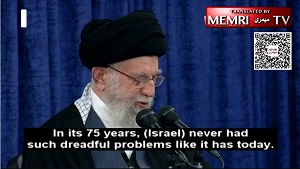
 Iran prowadzi wojnę z narodem palestyńskim
Iran prowadzi wojnę z narodem palestyńskim
Bassem Eid
Tłumaczenie: Małgorzata Koraszewska
Mam powody, by rozumieć, w jaki sposób te obce państwa manipulują narodem palestyńskim. Kiedy byłem dzieckiem, nasza rodzina została przymusowo przeniesiona z naszego domu we wschodniej Jerozolimie do obozu dla uchodźców Szuafat, nie przez Izrael, ale przez Jordanię. Dziś Gaza przekształciła się w bazę grup terrorystycznych, które realizują program irański, a nie palestyński. Około jedna czwarta wszystkich rakiet PIJ wystrzelonych w walkach w tym tygodniu zawiodła i wylądowała w Strefie Gazy; co najmniej czterech palestyńskich cywilów, w tym dzieci, zginęło w Strefie Gazy tylko 10 maja w wyniku nieudanych startów rakiet. A jednak dzień po dniu i noc po nocy brutalny atak rakietowy trwa [zawieszenie broni zostało zawarte 14 maja, MK], uniemożliwiając normalne życie w wielu izraelskich społecznościach, co wymaga ukierunkowanej reakcji obronnej Sił Obronnych Izraela (IDF), operacji „Tarcza i strzała”, co całkowicie zatrzymało normalne, codzienne życie w Strefie Gazy.
Ze strategicznego punktu widzenia tragedia trwającej eskalacji oznacza utratę szans politycznych i ekonomicznych, dla narodu palestyńskiego. Zachodni Brzeg i Strefa Gazy mają wiele wspólnego z Izraelem, który odniósł najbardziej niezwykły sukces gospodarczy na Bliskim Wschodzie, a którego nie można przypisać paliwom kopalnym. Wielokrotnie zapraszano Palestyńczyków do przyłączenia się do sąsiadów w strefie pokoju i dobrobytu, którą nieżyjący już izraelski mąż stanu i rozjemca Szimon Peres nazwał „Nowym Bliskim Wschodem”. Jednocześnie kierownictwo palestyńskie co najmniej trzykrotnie (w latach 2000, 2001 i 2008) odrzucało kompleksowe porozumienia pokojowe z Izraelem, które stworzyłyby niepodległe państwo palestyńskie, rozwiązały problem uchodźców i zakończyły kryzys. Zamiast tego nasi przywódcy – terrorysta Jaser Arafat i wieczny dyktator Mahmoud Abbas, obecnie sprawujący dziewiętnasty rok swojej czteroletniej kadencji prezydenckiej – zmuszają nas do niekończącej się wojny.
To, co dzieje się teraz na Bliskim Wschodzie, jest bardzo proste. Teokratyczny reżim ajatollahów w Iranie, nie zaspokojony naruszaniem godności kobiet i wieszaniem młodych demonstrantów, stara się narzucić swoją apokaliptyczną średniowieczną wizję całemu regionowi. Tak jak frakcje terrorystyczne, które twierdzą, że palestyńskie przywództwo było wykorzystywane jako entuzjastyczne pionki w faszystowskich wojnach o wywyższenie się, prowadzonych przez panarabski reżim Gamala Abdula Nasera w Egipcie i totalitaryzm Baas w Iraku Saddama Husajna, PIJ i Hamas próbują teraz wciągnąć naród palestyński w krwawe intrygi Iranu. Mam lepszy pomysł. Dajmy naszym rodzinom i naszym dzieciom pokój i pomyślność, a nie pociski i ból. Zawrzyjmy porozumienie z Izraelem, zamiast niekończących się walk i religijnej tyranii pod rządami Iranu.
Bassem Eid – Znany palestyński działacz na rzecz praw człowieka. Urodził się w 1958 roku w Jerozolimie wschodniej, gdzie nadal mieszka. Początkowo zajmował się naruszaniem praw człowieka przez żołnierzy Izraelskiej Armii Obronnej, stopniowo rozszerzając swoje zainteresowania o naruszania praw człowieka przez władze Autonomii Palestyńskiej i palestyńskie służby bezpieczeństwa. W 1996 roku założył organizację, Palestinian Human Rights Monitoring Group in 1996, która przerwała działalność w 2011 roku. Obecnie pracuje jako badacz i analityk w izraelskiej telewizji. Ujawnianie naruszeń praw człowieka przez Palestyńczyków wobec Palestyńczyków dostarczyło mu tysiące wrogów wśród sympatyków Palestyńczyków.
Zawartość publikowanych artykułów i materiałów nie reprezentuje poglądów ani opinii Reunion’68,
ani też webmastera Blogu Reunion’68, chyba ze jest to wyraźnie zaznaczone.
Twoje uwagi, linki, własne artykuły lub wiadomości prześlij na adres:
webmaster@reunion68.com





